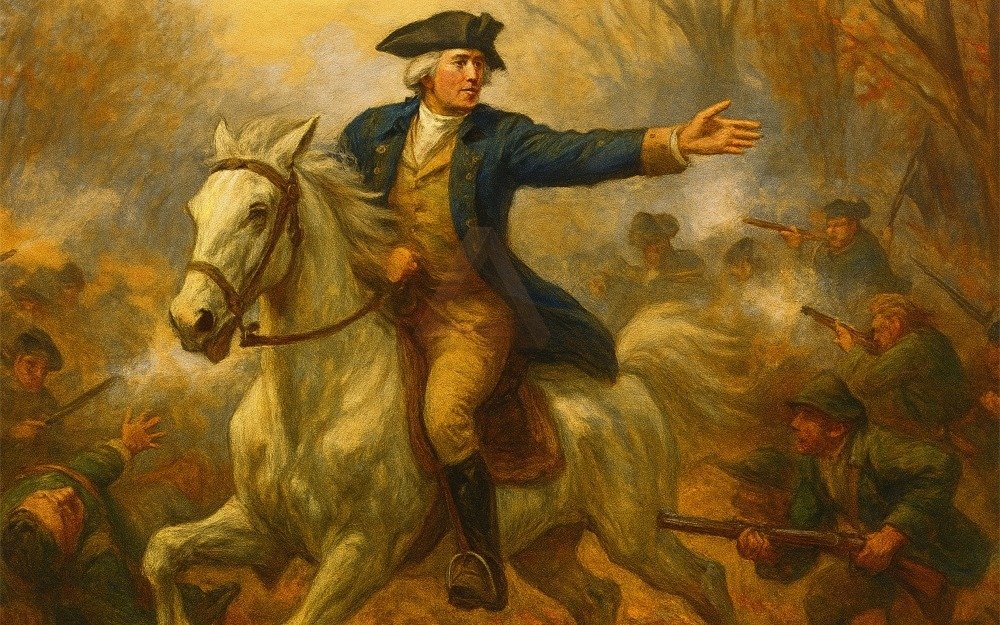
George Washington’s survival in battle often defied logic. From the chaos of Monongahela to the daring charge at Princeton, he emerged unscathed while death claimed those around him. His men saw it. His enemies noted it. And Washington himself, though reserved, acknowledged it. Was it providence, luck — or something else?
The Battle of Monongahela (1755)
In July 1755, a young George Washington rode with British General Edward Braddock into the Ohio Valley. Their mission: to seize Fort Duquesne from French and Native American forces. Braddock’s column — nearly 1,300 strong — marched in European formation through dense forest, unaware they were walking into an ambush.
The enemy struck with precision. French troops and Native warriors fired from concealed positions. British officers, easily identifiable by their uniforms and mounted positions, were targeted first. Braddock was mortally wounded. Chaos followed.
Washington, then just 23, had no formal command. Yet he rode through collapsing lines to rally the troops. He had two horses shot out from under him and four bullets pierce his coat, but he was never hit.
“By the all-powerful dispensations of Providence, I have been protected beyond all human probability and expectation; for I had four bullets through my coat, and two horses shot under me, yet escaped unhurt, altho’ death was levelling my companions on every side.”
—George Washington, Letter to John A. Washington, July 18, 1755
Source: Mount Vernon Digital Archive
The battle was a disaster for the British. Nearly 900 were killed or wounded. Washington’s survival became a point of fascination. Years later, Native leaders reportedly said they had aimed at him repeatedly but could not hit him. One called him “spirit-protected.”
The Battle of Princeton (1777)
Fast forward to January 3rd, 1777. Washington, now Commander-in-Chief of the Continental Army, faced British forces near Princeton, New Jersey. Morale was low. Supplies were thin. The winter was brutal.
During the battle, American troops began to falter. Washington rode forward — within thirty yards of enemy lines — and rallied his men with a shout:
“Parade with me my fine fellows, we will have them soon!”
—George Washington, Battle of Princeton, January 3, 1777
Source: American Battlefield Trust
His officers were stunned. One reportedly covered his eyes, unable to watch what he assumed would be Washington’s death. But again, Washington survived untouched. The counterattack succeeded. Princeton was a turning point in the war.
Native Accounts and Battlefield Lore
Accounts from Native American leaders — especially those who fought at Monongahela — add a layer of mysticism. One Shawnee chief reportedly said:
“He is not born to be killed by a bullet. I had seventeen fair shots at him… but could not bring him to the ground.”
—Attributed to a Native sachem recalling the Battle of Monongahela, as recorded by Dr. James Craik, 1770
Source: Mount Vernon Digital Encyclopedia
While these accounts were often filtered through colonial retellings, they reinforced the myth. Washington wasn’t just lucky — he was untouchable.
Cultural Echoes and Presidential Mythmaking
Washington’s battlefield survival became part of his presidential aura. Later generations would thread similar myths around other presidents:
- Abraham Lincoln reportedly dreamed of his own death days before his assassination.
- Ronald Reagan survived an assassination attempt in 1981 and later joked about it with characteristic bravado. Some believe his survival marked the end of the so-called Curse of Tippecanoe — a pattern in which presidents elected in years divisible by twenty met untimely deaths.
- Donald Trump, during his presidencies, has often invoked divine protection and destiny in speeches — threading mythic language into political identity.
Washington’s “Bulletproof” legend was the prototype. It combined battlefield grit with moral purpose and created a mythic template for leadership under fire.
Legacy and Interpretation
Historians rarely dismiss the battlefield accounts outright. The chaos at Monongahela and the charge at Princeton were well documented. But when it comes to the myth that Washington was somehow protected, they tend to pause.
Some treat it as morale psychology. Others point to terrain, timing, and the unpredictability of musket fire. Few try to explain it fully. Most simply note that Washington kept showing up alive where he shouldn’t have survived.
Still, the quotes remain. The coat with bullet holes was real. The horses were real. The men who died beside him were real. And Washington’s survival — again and again — was real.
Whether by providence or probability, George Washington’s battlefield record remains one of the most uncanny in American history.
🔗 Think that was strange? There’s more. Explore our full Oval Office Oddities archive.
References
[1] Washington, G. (1755). Letter to John A. Washington, July 18, 1755. Mount Vernon Digital Archive. Retrieved September 2025.
[2] Chernow, R. (2010). Washington: A Life. Penguin Press.
[3] Ellis, J.J. (2004). His Excellency: George Washington. Knopf. Explores Washington’s leadership style and battlefield instincts.
[4] Smithsonian Magazine. (2006). Washington’s War Tactics. Retrieved September 2025.
[5] National Archives. (n.d.). Founders Online. Retrieved September 2025.
[6] Mount Vernon. (n.d.). George Washington’s Military Career. Retrieved September 2025.
[7] American Battlefield Trust. (n.d.). Battle of Princeton. Retrieved September 2025.
